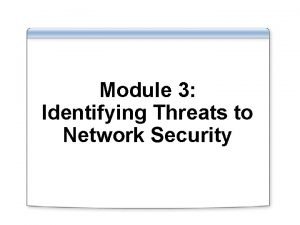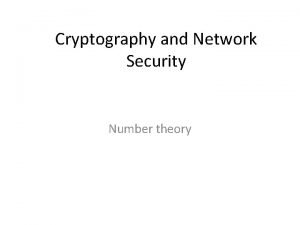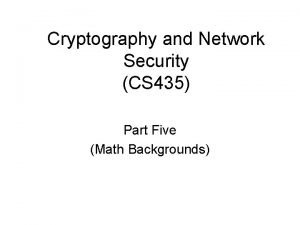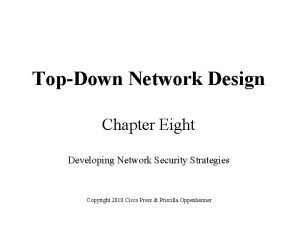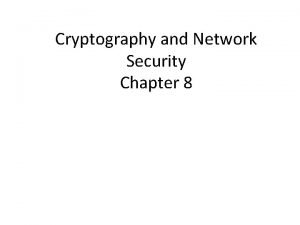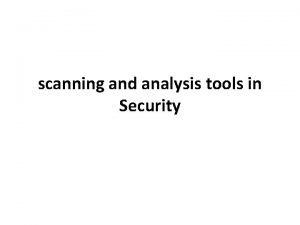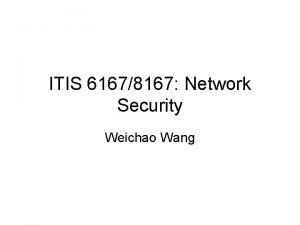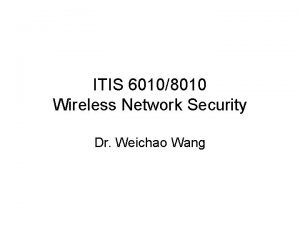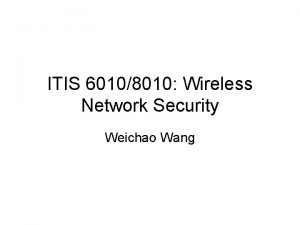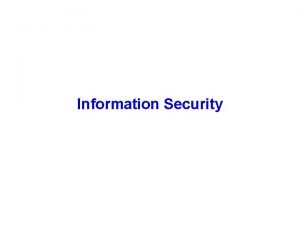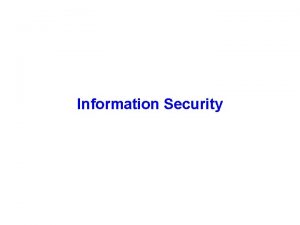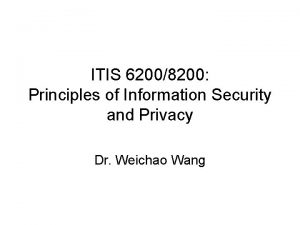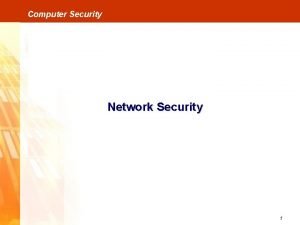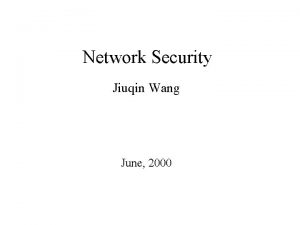ITIS 61678167 Network and Information Security Weichao Wang









































- Slides: 41

ITIS 6167/8167: Network and Information Security Weichao Wang

Contents • ARP protocol and ARP poisoning – How ARP works – ARP poisoning – Security impacts – Mitigation mechanisms • IP fragmentation and attacks – IP fragmentation – Attacks – Mitigation mechanisms 2

3

Ethernet address • Layered model of Internet • Separation of IP address and physical address • How does IP routing works – Example 4

• IP address – 32 bits (IPv 4) • Ethernet address – 48 bits – Different hardware vendors get different chunk of addresses – Can be broadcast or unicast address – Mapping b/w IP and Ethernet address can change 5

• IP routing needs the mapping b/w IP addresses and physical addresses – Static mapping (pro. NET or token ring) • Physical address = f (IP address) – Dynamic binding • More flexible • Needs a protocol to accomplish this task – Address Resolution Protocol (ARP) 6

• Ethernet frame format Preamble and CRC: only used by hardware and users will not see them Frame-type: 0 x 0800 (IP), 0 x 0806 (ARP), 0 x 8035 (RARP) Data part: 46 to 1500 octets 7

Example of ethernet packet 8

• Destination physical address: 02 07 01 00 27 ba • Source physical address 08 00 2 b 0 d 44 a 7 • Protocol type: 0800 (IP) • More details of the packet: this is an ICMP packet 9

10

ARP protocol • Motivation – Ethernet card only needs to recognize ethernet address – Upper layer (IP) only knows IP address – Routing table entry – The user have to map the IP address to physical address 11

• ARP protocol – Machine A want to send a packet to B, but only know B’s IP address – Machine A broadcast an ARP request with B’s IP address (using broadcast physical address) – All nodes receive the request – B replies with its physical address – Machine A adds the address into its ARP cache – A sends packets to B 12

13

ARP encapsulation • In ethernet, frame type for ARP is 0 x 0806 ARP packet 14

ARP packet format when used with Ethernet 15

• The format is general enough to work with different physical address and protocol address • Details of ARP packet (Fixed length part) – Hardware type (2 bytes): 1 for ethernet – Protocol type (2 bytes): 0 x 0800 for IP – HLEN (1 byte): hardware address length. 6 for ethernet – PLEN (1 byte): protocol address length. 4 for IP – Operation (2 bytes): 1=ARP req, 2=ARP reply, 3=RARP req, 4=RARP reply 16

• Varying parts of ARP packets – Sender’s physical address: 6 byte in our example – Sender’s protocol address: 4 byte – Target’s hardware address: 6 byte – Target’s protocol address: 4 byte 17

• ARP cache – To reduce ARP overhead, the machine keeps a cache for recently got IP-PHY address mapping – Cache has a limited size: replacement policy – ARP entry has a lifetime: why do not we keep it forever? ? 18

• How does the node learn ARP information – From received ARP request – From received ARP reply (no matter they have sent a ARP request or not) (depend on OS) – Gratuitous message: both the source and destination address are the same • Used to detect IP conflict • When physical address changes, use this to notify other nodes after reboot 19

20

ARP poisoning • Potential attack to ARP – There is no protection on the mapping b/w Physical and IP address – An example attack: if ARP cache is poisoned, the packet going to node A will be sent to Node B’s physical address, and node B will get them. – Is this the same as promiscuous mode? Not really 21

• Two simple and not-so-effective MAC address attacks – Poison a switch by sending out an ethernet packet with the target’s physical address as the source of the packet. The switch tries to learn from the packet. – Problems • The real node also sends out packet • Static configuration of switches 22

• Attack 2: – Sends out ARP reply and tries to beat the real node – Problem: the conflict is relatively easy to detect 23

• ARP cache poisoning – Through ARP poisoning, the packets targeting at node A may be sent to node B – Methods to poison ARP cache • ARP request • ARP reply • Gratuitous packets – Instead of broadcast, we can use unicast to poison node 24

• Examples of attacks – Send a unicast ARP request to poison ARP cache – Send a unicast ARP reply to poison ARP cache 25

• Which systems are vulnerable to ARP poisoning? – Windows 9 x, NT, 2000, XP – Solaris 8 – Linux Kernel 2. 2 and 2. 4 – Cisco IOS 12 – Nokia IPSO 3. 5 26

27

• Complicated attacks and their impacts • Man-in-the-middle attack – Cheat both sides of a connection and get access to the traffic b/w them – The malicious node will forward packets to both sides to avoiding detection – Disable attacker’s ICMP redirect functionality – Microsoft IE certificate can be compromised by this attack 28

• Hijacking HTTP connections and run a manipulated web server through Mi. M attacks • Escaping firewall – Some companies use IP based authentication and only allow a few IP addresses to get out (HTTP server, mail server) – Through ARP poisoning, you can bypass the firewall 29

• Do. S attacks – After poisoning the ARP cache, discard all packets sent to you – Using a non-existing physical address to poison ARP cache • Poisoning a SMTP relaying server to send out junk mails 30

• Defending against ARP poisoning – Network IDS: detect duplicate IP address or flip-flop of the IP-PHY bindings – Host IDS: maintain a record of IP-PHY bindings, detect abnormal changes of the bindings (arpwatch in UNIX) – Do not use IP-address based authentication 31

32

IP protocol and fragmentation • IP layer provides the fundamental service in Internet: unreliable, connectionless, and best-effort based packet delivery – Unreliable: packet may lost, duplicated, delayed, out of order – Connectionless: every packet is handled independently – Best-effort: no quality guarantee 33

• IP protocol will – Define the format of IP packet – Routing – Determine • Packet processing procedures • Error reporting and handling procedures 34

IP encapsulation • In ethernet, frame type for IP is 0 x 0800 IP header IP Data 35

IP format 36

• Details of IP packet – Vers: current version is 4 – HLEN: header length in 32 bit word. Usually is 5 (20 byte), max can be 60 bytes (IP options) – Type of services: usually all 0 (best effort), can be used for diffserv and Qo. S – Total length: 16 bit can represent 64 K byte long packet 37

• Identification, flags, and offset: used for fragmentation and reassemble (later) • TTL: time to live: number of routers a packet can pass. – Every router will reduce this value by one. When reach 0, the packet will be discarded. – Can be used to prevent routing loop – Use TTL to implement traceroute 38

• Type: the high level protocol the IP packet contains: ICMP (0 x 01), TCP (0 x 06), UDP (0 x 11) • Header checksum • Example: an ICMP packet b/w 128. 10. 2. 3 and 128. 10. 2. 8. Header length is 20 bytes. 39

40

• IP header options – Record route option • Intermediate routers will attach their IP address to the packet – Timestamp option • Intermediate router attach 32 bit timestamp – Source routing option • Strict source routing • Loose source routing: allow multiple hops b/w routers 41
 Wireless security in cryptography
Wireless security in cryptography Private secuirty
Private secuirty Module 3: information and network security
Module 3: information and network security Osi security services
Osi security services Security guide to network security fundamentals
Security guide to network security fundamentals Electronic mail security in network security
Electronic mail security in network security Security guide to network security fundamentals
Security guide to network security fundamentals Security guide to network security fundamentals
Security guide to network security fundamentals Visa international security model
Visa international security model Explain about cnss security model
Explain about cnss security model Electronic commerce security
Electronic commerce security Network reliability and security
Network reliability and security Network security design
Network security design Modulo table
Modulo table Introduction to cryptography and network security
Introduction to cryptography and network security Number theory in cyber security
Number theory in cyber security Firewall in cryptography and network security
Firewall in cryptography and network security Authentication in cryptography and network security
Authentication in cryptography and network security Three classes of intruders in network security
Three classes of intruders in network security Primitive root in cryptography and network security
Primitive root in cryptography and network security Cryptography and network security 6th edition pdf
Cryptography and network security 6th edition pdf Cryptography and network security pearson
Cryptography and network security pearson Source
Source Cryptography and network security 4th edition
Cryptography and network security 4th edition Euler's theorem in cryptography and network security
Euler's theorem in cryptography and network security Finite fields in cryptography and network security
Finite fields in cryptography and network security Dsa in network security
Dsa in network security Gcd(1970,1066)
Gcd(1970,1066) Pgp in cryptography and network security
Pgp in cryptography and network security Network design and security
Network design and security Network and security greensboro
Network and security greensboro Euler's theorem in cryptography and network security
Euler's theorem in cryptography and network security Malicious software in cryptography
Malicious software in cryptography Introduction to cryptography and network security
Introduction to cryptography and network security Computer and network security
Computer and network security Rsa algorithm in cryptography and network security
Rsa algorithm in cryptography and network security Introduction to cryptography and network security
Introduction to cryptography and network security Difference between virtual circuit and datagram network
Difference between virtual circuit and datagram network Features of peer to peer network and client server network
Features of peer to peer network and client server network Network centric computing
Network centric computing Scanning and analysis tools
Scanning and analysis tools Professional issues in cyber security
Professional issues in cyber security


